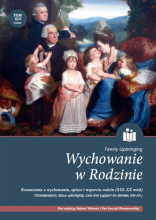Zakładanie rodziny w krajach czeskich w pierwszej
połowie XIX wieku
Founding a Family in Czech Society in the First Half of the 19th Century
Author(s): František Čapka, Jaroslav VaculikSubject(s): Education, Sociology, Social history
Published by: Zakład Historii Edukacji w Instytucie Pedagogiki Uniwersytetu Wrocławskiego
Keywords: family; marriage; wedding; parents; social standing; dowry; mother; children
Summary/Abstract: In the period in question, the family in the Czech Lands was usually comprised of between five and seven members – father, mother and children. Founding a family was subject to the agreement of the lord of the manor (in the countryside) or the municipal authority (in the town). „Confirmation of probity” was requested from the seigniorial authorities in Catholic parishes even after the abolition of serfdom in the Habsburg monarchy (1781), while the approval of the couple’s legal representatives (parents) was also required in the case of the marriage of people younger than twenty-four (the age of maturity). Partners were chosen by parents according to their property and social standing. People to be married were generally not only from the same social class, but also from the same place or nearby in the surrounding area. No lower age limit for marriage was stipulated by the law, though grooms younger than twenty were the exception, while around a fifth of brides were younger than twenty. The family represented a small social group comprised of individuals joined by marriage, consanguinity or adoption. It was seen as an institution to which the greatest regard was given. Its integrity was protected by a number of laws and traditions. In the first half of the nineteenth century, women usually got married between the ages of twenty and twenty-five, and men between the ages of twenty-five and thirty. The upperage limit, however, approached a figure of as much as fifty, or even exceeded it, for men living in towns. The age of brides was also higher in town families, among which couples being engaged for many years was also not unusual. This was particularly common among clerical workers, who had to attain a certain standing in order to be able to found a family. What’s more, according to the imperial decree of 1800, every state or municipal official needed the agreement of his superior if his pay had not reached a certain financial „ceiling”. A marriage licence was also conditional to the attainment of a certain service position for policemen, soldiers, financial guards and teachers. People entered into marriage earlier in Moravia than in Bohemia. Around ten percent of the population of the Czech Lands remained unmarried. As far as women were concerned, these were maids and the daughters of less a ffluent tradesmen, clerical workers or poor aristocratic families that did not have a sufficiently large dowry. In the first half of the nineteenth century, there was an increasing number of „deferred weddings”, particularly in the towns, when a couple became married only when they already had a number of illegitimate children; this was particularly evident in the border areas inhabited by a German population.
Journal: Wychowanie w Rodzinie
- Issue Year: XIV/2016
- Issue No: 2
- Page Range: 307-316
- Page Count: 10
- Language: Polish

